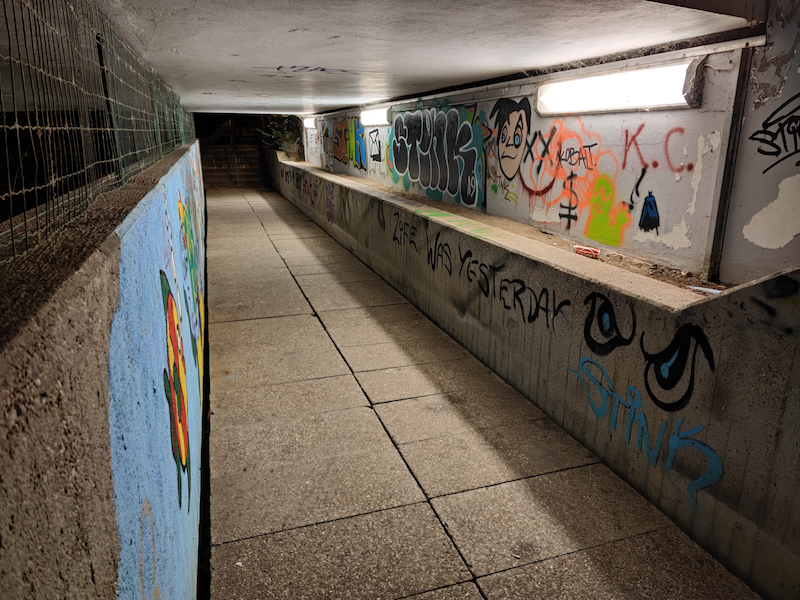The Xiaomi Mi 11 Review: A Gorgeous Screen and Design
by Andrei Frumusanu on March 10, 2021 8:00 AM EST- Posted in
- Mobile
- Smartphones
- Xiaomi
- Snapdragon 888
- Mi 11
Camera - Low Light Evaluation
Low-light photography of the Mi 11 on paper shouldn’t be exactly a strong-point of the device: Due to the way the main sensor is 2x2 binning to 27MP at the lowest resolution, it means that it effectively has smaller pixels than comparable 12MP shooters, or even the other 1/1.3”-class sensors from Samsung or even Huawei. On top of this, the Mi 11 has a smaller aperture versus the Mi 10 Pro in the optics. Still, the new phone has a newer SoC so maybe there’s some new processing algorithms which could come to play in terms of generationally improving the low-light capabilities of the phone.

[ Mi 11 - ] [ Mi 10 Pro - ]
[ S21U(S) - ] [ S21U(E) - ]
[ S21(E) - ] [ S20+(E) - ]
[ Note20U(S) - ] [ iPhone 12 Pro - ]
[ Mate40 Pro - ] [ Pixel 5 - ]
[ X-T30 ( ) ]
In the first scene here, we see a very different result when looking at the Mi 11 compared to the Mi 10 Pro, and it’s actually not a positive one. The Mi 11 regresses in terms of dynamic range, posting brighter highlights (than they should be) and darker shadows with less detail. The EXIF says the Mi 11 had a twice as long exposure – though the loss of detail in the shadows points out that the night mode processing is very different.
Although the Mi 11 has strong natural detail retention, the competition just does better in terms of bringing out details in the darkness.
The ultra-wide’s night mode hardly makes any difference on the Mi 11 which is a bit weird, as the Mi 10’s was quite adequate.

[ Mi 11 - ] [ Mi 10 Pro - ]
[ S21U(S) - ] [ S21U(E) - ]
[ S21(E) - ] [ S20+(E) - ]
[ Note20U(S) - ] [ iPhone 12 Pro - ]
[ Mate40 Pro - ] [ Pixel 5 - ]
[ X-T30 ( ) ]
In terms of colour temperature, the Mi 11 was quite off in terms of the magenta hue. Where’s still reasonable amount of even light, the Mi 11 again does really well with details due its higher resolution sensor.

[ Mi 11 - ] [ Mi 10 Pro - ]
[ S21U(S) - ] [ S21U(E) - ]
[ S21(E) - ] [ S20+(E) - ]
[ Note20U(S) - ] [ iPhone 12 Pro - ]
[ Mate40 Pro - ] [ Pixel 5 - ]
[ X-T30 ( ) ]
Here, although the Mi 11 overdid it in terms of the colour temperature compensation and really isn’t representative of the hue of the sodium vapour lamps, the Mi 11 still somehow manages a very good compositions in the tone curves.

[ Mi 11 - ] [ Mi 10 Pro - ]
[ S21U(S) - ] [ S21U(E) - ]
[ S21(E) - ] [ S20+(E) - ]
[ Note20U(S) - ] [ iPhone 12 Pro - ]
[ Mate40 Pro - ] [ Pixel 5 - ]
[ X-T30 ( ) ]
In terms of raw dynamic range in night mode, the Mi 11 doesn’t fare as well as some of the competition, however it’s still above average, and it does a much better tone-mapping than the Mi 10, maintaining better mid-tone contrast whereas the predecessor tended to make things very flat.

[ Mi 11 ] [ Mi 10 Pro ]
[ S21U(S) ] [ S21U(E) ]
[ S21(E) ] [ S20+(E) ]
[ Note20U(S) ] [ iPhone 12 Pro ]
[ Mate40 Pro - ] [ Pixel 5 ]
[ X-T30 ( ) ]
In even more low-light conditions, the Mi 11 does very well in the overall scene. The phone prefers to bring out shadows rather than maintaining highlight details, but that’s generally acceptable for the end-result.
Unfortunately the ultra-wide isn’t really usable here, the Samsung phones and their superior sensor as well as Huawei are well ahead in terms of quality.

[ Mi 11 ] [ Mi 10 Pro ]
[ S21U(S) ] [ S21U(E) ][ S21(E) ] [ S20+(E) ] [ Note20U(S) ]
[ iPhone 12 Pro ] [ Mate40 Pro - ] [ Pixel 5 ]
[ X-T30 ( ) ]
Finally, a scene that I did just for fun was the night sky when in handheld mode. It’s not really a realistic shooting mode, but it does show some of the processing styles of the phones. The Mi 11 has better noise control than the Mi 10 but due to the exposure being twice as long we’re seeing obvious ghosting and mirror images in the stars – either that, or the image stacking algorithm from Xiaomi isn’t quite as strong as the competition.
Low-light verdict: Not the best, but still quite good
The general conclusion for low-light capabilities of the Mi 11 is that it’s a plenty adequate shooter with some strengths as well as some weaknesses. Xiaomi’s processing isn’t quite as strong as Samsung’s, but does better than other vendors bar Huawei. The capabilities of the sensor are still plenty, and in general it’s a competent shooter. On the ultra-wide module however, the sensor really is far too weak, and even night mode cannot save it, producing images that are far too dark and barely usable compared to other high-end competitors.










85 Comments
View All Comments
inighthawki - Thursday, March 18, 2021 - link
What a well thought out reply. Thanks.zamroni - Wednesday, March 17, 2021 - link
I still use galaxy s9 as my current phone.Curved edge screen sucks.
It also less durable.
My screen replacement also costed ~$100 more than flat s10e
Wereweeb - Wednesday, March 10, 2021 - link
Preach, brother.Hifihedgehog - Sunday, March 14, 2021 - link
Curved edges: Your scientists were so preoccupied with whether or not they could, they didn't stop to think if they should.Findecanor - Wednesday, March 10, 2021 - link
Curved edge means more likely to break if droppedballsystemlord - Wednesday, March 10, 2021 - link
Shouldn't it be less likely because of the force vectors involved?RSAUser - Thursday, March 11, 2021 - link
No due to how the glass is folded, force distribution is worse. Also getting cases that work well is more difficult.Spunjji - Thursday, March 11, 2021 - link
In theory, but the main problem is the total inability to fit a full-coverage screen protector.Unashamed_unoriginal_username_x86 - Wednesday, March 10, 2021 - link
X-T30 83mm photo seems to give a 404 on the first pic in the HDR section (green bike)5j3rul3 - Wednesday, March 10, 2021 - link
Is Mi 11 using it LTPO OLED?